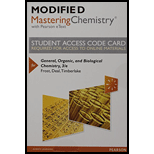
Concept explainers
a.
To determine:
If the reaction of nitrogen gas with hydrogen gas to form ammonia is a reversible or irreversible reaction.
Introduction:
The
b.
To determine:
If the reaction of methane and oxygen gas to form carbon dioxide and water is a reversible or irreversible reaction.
Introduction:
The chemical reaction is the process in which one or more reactant molecules react to form one or more products. Every chemical reaction is associated with a chemical change which is due to the difference in energy of reactants and products.
c.
To determine:
If the reaction of
Introduction:
The chemical reaction is the process in which one or more reactant molecules react to form one or more products. Every chemical reaction is associated with a chemical change which is due to the difference in energy of reactants and products.
Want to see the full answer?
Check out a sample textbook solution
Chapter 5 Solutions
Modified Mastering Chemistry with Pearson eText -- Standalone Access Card -- for General, Organic, and Biological Chemistry (3rd Edition)
- At equilibrium, the free energy of the reactants is equal to the free energy of the products. true or falsearrow_forwardDraw (and label) an energy diagram that fits each description: a. An endothermic reaction with a high Ea b. A reaction that has a low Ea and ΔH is negative c. A slow reaction in which the products are at a lower energy than the reactants.arrow_forwardBased on the relative ΔG‡ values for the forward and reverse reactions (and assuming we haven’t added a lot of heat energy into the system) is this SN2 reaction reversible or irreversible?arrow_forward
- A chemical interaction in which the products contain less free energy than the reactants is called a(n) ____ reaction.arrow_forwardCorrelate the free energy of the system (reactants/transition state/product) as the enzymatic reaction progressesarrow_forwardWhat major factor leads to a decrease in entropy as this reaction takes place?arrow_forward
- The standard free energy change for the reaction CH4(g)+2O2(g) -> CO2(g) + 2H2O(l) is -194.8 kcal at 25ºC and -191.82 kcal at 75ºC. Calculate the heat of reaction at 25ºC.Ans: -212.6 kcalarrow_forwardMark the reaction or reactions in Figure 10 that are possible. * 1- A 2- B 3- C 4- Darrow_forwardIf the free energy change DG for a reaction is -46.11 kJ/mol, the reaction is: A) at equilibrium B) endergonic C) endothermic D) exergonic 5. E) exothermicarrow_forward
- Which of the following is a property of exergonic reactions? The products of exergonic reactions have more stored energy than the reactants. The products of exergonic reactions have more stored energy than the reactants. Exergonic reactions release free energy Exergonic reactions release free energy Exergonic reactions are also referred to as non-spontaneous reactions Exergonic reactions are also referred to as non-spontaneous reactionsarrow_forwardO2 + 2H+ + Fe --> Fe2+ + H2O In the reaction, the reactant being reduced is?arrow_forwardWhich reaction will happen fasterarrow_forward
 Living By Chemistry: First Edition TextbookChemistryISBN:9781559539418Author:Angelica StacyPublisher:MAC HIGHER
Living By Chemistry: First Edition TextbookChemistryISBN:9781559539418Author:Angelica StacyPublisher:MAC HIGHER Chemistry & Chemical ReactivityChemistryISBN:9781337399074Author:John C. Kotz, Paul M. Treichel, John Townsend, David TreichelPublisher:Cengage Learning
Chemistry & Chemical ReactivityChemistryISBN:9781337399074Author:John C. Kotz, Paul M. Treichel, John Townsend, David TreichelPublisher:Cengage Learning Chemistry & Chemical ReactivityChemistryISBN:9781133949640Author:John C. Kotz, Paul M. Treichel, John Townsend, David TreichelPublisher:Cengage Learning
Chemistry & Chemical ReactivityChemistryISBN:9781133949640Author:John C. Kotz, Paul M. Treichel, John Townsend, David TreichelPublisher:Cengage Learning- Chemistry: Matter and ChangeChemistryISBN:9780078746376Author:Dinah Zike, Laurel Dingrando, Nicholas Hainen, Cheryl WistromPublisher:Glencoe/McGraw-Hill School Pub Co

 Introductory Chemistry: A FoundationChemistryISBN:9781337399425Author:Steven S. Zumdahl, Donald J. DeCostePublisher:Cengage Learning
Introductory Chemistry: A FoundationChemistryISBN:9781337399425Author:Steven S. Zumdahl, Donald J. DeCostePublisher:Cengage Learning





